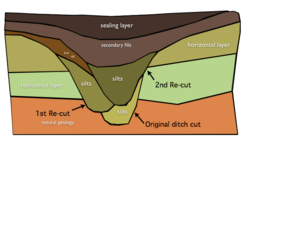Processual Archaeology facts for kids
Processual archaeology (also known as New Archaeology) is a way of studying the past that tries to be very scientific. Archaeologists are like detectives who study people from long ago by looking at the objects they left behind. These objects are called artifacts. Processual archaeologists use special methods to find general rules. These rules help explain why people around the world and throughout history acted in similar ways. They want to understand the reasons behind human culture.
Contents
What is Processual Archaeology?
Processual archaeology started in the 1960s. It is a specific way of doing archaeology that many experts choose to follow. Before this, archaeologists used a method called 'culture history'. That method focused on creating histories for certain places. Culture history archaeologists would start with a modern culture. Then, they would trace its roots back as far as possible.
These archaeologists dug deep, square holes called "units." They did this to find the oldest objects. When you dig, the newest things are usually near the surface. The oldest things are found much deeper down. By knowing the order of objects, archaeologists could learn about a place's history.
Processual archaeology is different. These new archaeologists dug larger areas. This helped them understand more about what was happening at a site. A site is a place important for archaeology. They also started using many scientific tools to study the past.
Lewis Binford and Anthropology
Lewis Binford was a famous processual archaeologist. He was active in the 1960s. Binford believed that archaeology should be like anthropology. Anthropology is the study of people, both past and present. It looks at all the different parts of being human.
Binford thought archaeologists should help anthropology grow. This includes understanding how cultures and societies change over time. He wanted to study many different things. This would show how human culture changed over time. He tried to do this in a very organized way. This means he followed clear rules that could be repeated. Binford also believed that some parts of culture were more important than others. He thought people's actions were sometimes based on hidden rules or forces.
How Processual Archaeologists Work
Processual archaeologists tried to create models. These models helped explain why and how people would act. They thought that humans often behave the same way. If people faced the same situations or choices, they would make similar decisions.
Processual archaeologists also made archaeology more scientific. They used methods like radiometric dating. This helps them figure out how old an artifact is. They also used other techniques to learn how an artifact was used. They even started making copies of old artifacts. This is called experimental archaeology. It helps them understand how the original items were made.
Another scientific method they used was ethnographic fieldwork. This means studying modern hunter-gatherer groups. Processualists believed that these groups might live similarly to ancient hunter-gatherers. This helps them understand the past better.
Impact and Modern Archaeology
Later, a new way of thinking called post-processualism appeared. It challenged processual archaeology. Post-processual archaeologists felt that processualists focused too much on objects. They thought they forgot about the people who made and used them. They also questioned the idea that humans always act logically. They challenged the belief that human behavior could be easily modeled. They also looked at the biases that might affect archaeological work.
Archaeology Today
Processual archaeology is still used today. However, it has changed since it first started. A big change came with computers. Computers helped archaeologists test their models. They could see if their ideas were accurate or not. Computers also allowed for more detailed studies of artifacts.
Not all archaeologists think the same way about the past. After processual archaeology, post-processual archaeology came along. It questioned many of the earlier ideas. Today, both processual and post-processual archaeologists exist. They both contribute to our understanding of the past.


